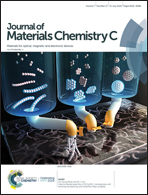A novel biomass-based reusable AIE material: AIE properties and potential applications in amine/ammonia vapor sensing and information storage†
Abstract
A novel biomass-based aggregation-induced emission (AIE) material, 4-chloro-2-(2-hydroxy-5-(methoxycarbonyl)phenylamino)benzoic acid (CHMPBA), was constructed by using (−)-methyl-3-dehydroshikimiate (3-MDHS) and 2-amino-4-chlorobenzoic acid via the tandem cross-coupling and aromatization reaction. AIE properties of CHMPBA were studied in ethanol, dimethyl sulfoxide, dimethyl formamide and tetrahydrofuran with gradually increasing water fractions and characteristic AIE phenomena were observed. Portable sensors for the detection of amine vapors were prepared by depositing CHMPBA on filter paper. Good selectivity, high sensitivity and real-time fluorescence quenching were observed when this portable sensor was exposed to ammonia vapor. The detection limit for ammonia vapor is up to 20 ppm in air. A plausible mechanism for the fluorescence “ON–OFF–ON” phenomenon in the detection of ammonia vapor was proposed based on the DFT calculations, 1H NMR tests and reusability studies. In addition, further practical application studies proved that CHMPBA might be commercially used as information storage material in the future.



 Please wait while we load your content...
Please wait while we load your content...